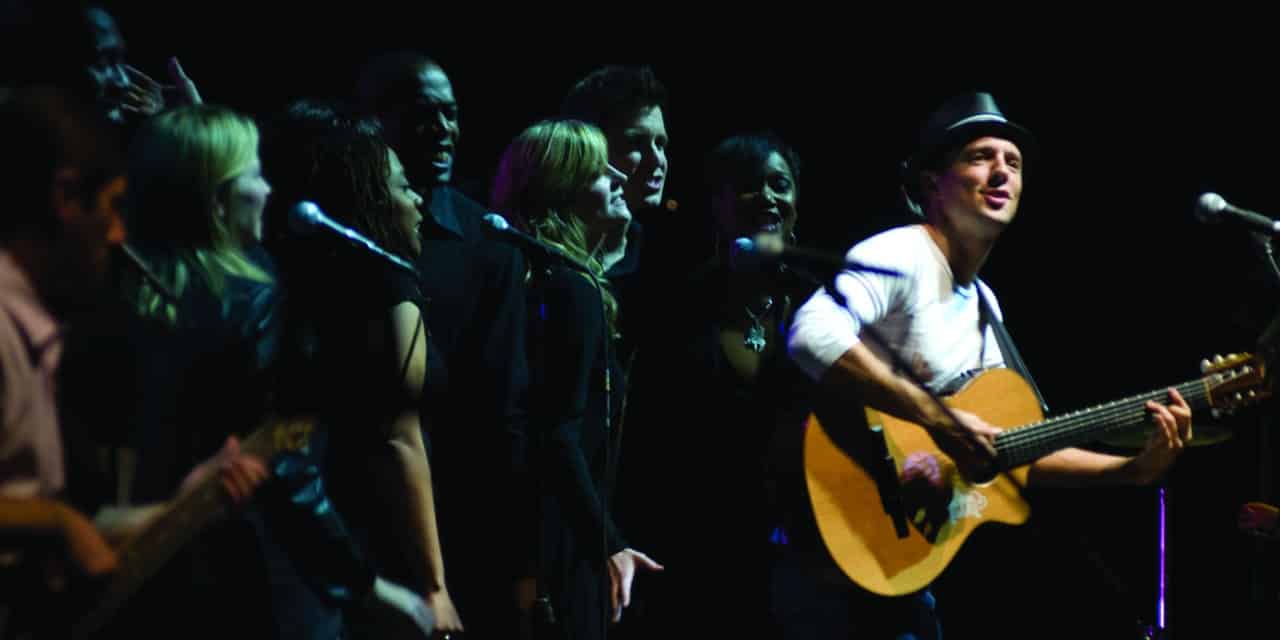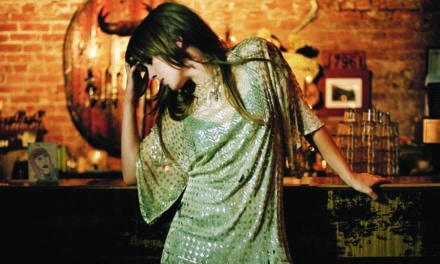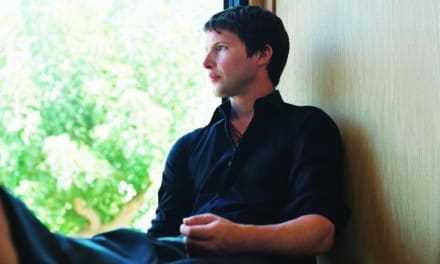A beautiful mess – jason mraz
written by: ben Bamsey
Photography by: Andrew Zaeh
Ten years ago, Jason Mraz had a few t-shirts, some paper fedoras and a dream. He stuffed them into a worn backpack and travelled cross-country from his home in Virginia to California – a musical gypsy with a desire to share songs and expose his eyes fully to the world. His flawlessly accurate and controlled voice began making love to music in the coffee shops of San Diego; it now resonates in stadiums from Spain to South America. The words that come out of him feel divine. He plays with them like a kid in the mud with absolutely no fear of getting dirty. Life is messy. Mraz knows it. But prose can provide perspective, even clarity. His songs are part dictionary, part Mad Libs, but more than anything, Mraz’s messages serve as ambassadors of comfort. If life’s jar is full of tails-up pennies, his music can help flip them over. Mraz is a missionary of love carrying a songbook that beckons people to give it and receive it freely. His map is full of proud pushpins, and his mind filters those experiences into enlightened wordplay that redefines wonderful. Mraz’s music is happy and hopeful, and engineered to help us all hug it out. And the best part of all… he has no plans to ever unpack that bag.
It’s the morning before Mraz kicks off his ambitious Gratitude Café Tour – a 50-date, international “celebration and awakening disguised as a tour.” But first, a final tune-up in Pennsylvania opening up for Dave Matthews Band. There’s a lot riding on these shows. Mraz has to prove he’s worthy to stand on modern music’s elite platform. The success of his third album, We Sing. We Dance. We Steal Things., placed him there alongside industry heavyweights Chris Martin, John Mayer and Jack Johnson. Staying in the ring with the big boys, though, means bringing Ali-like power and poetry to the mic every night. My first question to Mraz was intended to be a mental jab to test his preparation. His answer knocked me out cold. “What did you fall asleep to last night?” I asked him – assuming he’d say lyrics to a song, a portion of the routine or thoughts on engaging the audience. Instead, he responded, “I fell asleep last night trying to define the word cult.” And from there I quickly learned that there are no ropes that can contain this man’s wisdom.
Mraz is a sushi-loving vegan who is into Buddhism, acupuncture and herbal remedies. When he’s not on the road, he lives with his cat in an unglamorous part of San Diego County surrounded by avocado trees, owls and coyotes. His solar powered home is always open to other artists who are encouraged to make music, cook or paint as they please. It’s a commune for creativity and is just fifteen minutes from the beach. World tours are built around the winter waves and his passion for catching as many of them as he can. He reads books about all types of religions and civilizations because he believes knowing a country’s history makes going to museums in Italy, drinking French wine and walking on Chinese soil FEEL better. Mraz is an avid photographer who released a travelogue of untouched Polaroids of people and places called a thousand things. He takes snapshots wherever his tour takes him, so that he can “slow down and SEE more on the walk through life.” When he gets sad, he puts on classical music so that “feeling down serves a purpose.” His favorite song of all-time is Maria Callas’s “O Mio Babbino Caro.” It makes him thankful to be a romantic. He believes in music’s invisible power, especially when it comes to shaping a child’s mind. That’s why money from each one of his concert tickets sold goes to Vh1’s “Save the Music” program. All these loves. All these truths. All these passions. Their sum has added up to some people claiming that Jason Mraz is into cults. “Why is that a bad thing?” he asked himself as he lay in bed that night. “I fell asleep realizing how cult is really just another word for culture, and if someone were to examine cult in a negative way, well then that’s them separating themselves from someone else’s interests. Because, I feel like the more I learn, the less I know. So if I only learn certain things, I’d sort of be trapped in a box, and I don’t want that.”
Listen to the music of the moment.
People dance and sing.
We’re just one big family.
And it’s our God-forsaken right to be loved.
If the world could sing in perfect harmony, Mraz’s “I’m Yours” would echo pleasantly through its canyons. The Bob Marley-like chord progression coupled with Mraz’s delightful delivery floats peace, love and joy down life’s river. Mraz calls it his “happy little hippie song,” and it has plucked the perfect string in so many hearts. On crappy days it just makes you feel better about things like medicated Gold Bond after an evening of Taco Bell and beer. “I’m Yours” took twenty minutes to write in 2004, and what Mraz thought would simply be a B-side acoustic demo, has now become the longest-running song in the history of Billboard’s Hot 100. It’s the only song to top all four U.S. radio airplay charts, and is currently the third best-selling digital single of all time. A classic like that has the potential to become Mraz’s “Brown-Eyed Girl,” a great over-requested song that just scratches the surface of his brilliance. But his songs are in a constant state of evolution and are rarely performed in the same way. “There’s always a way to change it up,” he says. “If it remains fresh for us, then it will definitely be fresh for the listeners as well.”

Half of the songs Mraz writes happen organically from grabbing a guitar and messing around with melodies. Sounds burst from his mouth first, and out of that exploration, words are born. He often types frantically filling page after page, then like a newspaper editor whose reporter buried the lede six feet deep, he slashes the text and moves it around until the story is told exactly the way it was intended. The other 50 percent of Mraz’s music is born through a process dubbed “The Songwriting Challenge.” It’s a game he plays with other musicians like Bob Schneider, a prolific songwriter out of Austin, Texas. Schneider will pick a word or phrase like “sewing machine,” for example, and then Mraz will have a week to write about that subject. There are no winners or losers, just pride on the line. As for this particular challenge, Mraz kicked its ass. “So first, I did an outline about what a sewing machine does, metaphorically, subjectively, objectively – and then I paired that up with the emotions that were happening in my life at the time,” he explains. “The result was ‘Details in the Fabric,’ which talked about Mother Nature’s sewing machine and how we’re all weaved together along with our emotions. Shit happens, you know, and that’s probably just the fault of faulty manufacturing.”
Calm down. Deep breaths. And get yourself dressed…
Instead of running around and pulling all your threads,
and breaking yourself up.
If it’s a broken part, replace it.
If it’s a broken arm, then brace it.
If it’s a broken heart, then face it.
And hold your own. Know your name.
And go your own way. And everything will be fine.
Mraz’s breakthrough hit was called “The Remedy.” It was released in 2002 on his debut album Wait For My Rocket to Come. Its upbeat sound helped it become one of the biggest jams of the following summer. But locked in the dance groove was this inspirational message: “I won’t worry my life away” – words first uttered from Mraz’s best friend, Charlie Mingroni, who was battling a rare form of cancer. The two met in 9th grade chorus, and as Charlie lay hairless in a hospital bed going through chemotherapy, he told a muted Jason, “Don’t worry; living through this is going to be the best thing. It is a gift.” Charlie was born on the 4th of July, and as Mraz drove home from that outlook-changing visit, he saw fireworks off the highway at Disneyland. “The Remedy” had written itself by the time he hit his front door… “We will cure this dirty old disease. Well, if you’ve got the poison, I’ve got the remedy.” Charlie beat cancer.
Jason grew up in Mechanicsville, Virginia. Coming from the country meant mowing the lawn, NASCAR and cigarettes. Cable TV and sidewalks did not exist. Jason’s parents divorced when he was young, but each left their musical imprint. It was Motown and Doo-wop at Dad’s place. Mom preferred Nat King Cole and Barry Manilow. On Saturdays, Jason brought out the boombox to breakdance in the backyard. By thirteen he was writing his own lyrics and fine-tuning his voice in choir. After high school, Jason moved to New York where he studied musical theater at the American Musical and Dramatic Academy. He taught himself how to play guitar in college and cracked up his friends by improvising songs on the spot. He knew he was called to be a musician, but instead of standing in lines to audition for parts written by other people, Jason wanted to create his own job.
Impressed by the storytelling of Bob Dylan, Willie Nelson and Neil Young, he longed to hit the road and see the American picture they had painted. So Mraz quit school and took that chance. He admits that he was scared during that drive to San Diego in 1999, but it didn’t take him long to figure out how to share his gift. There was family waiting to be discovered inside those coffee shops. He met his musical soul mate, Toca Rivera, early on at Java Joe’s. They’ve been harmonizing ever since – Mraz on acoustic guitar, Rivera on drums. Their vocals waft through the air on fan favorite “Sleeping to Dream,” like a beautiful perfume. They’ve played Cupid so many times over the years with the endearing ballad. At a recent stop on the Gratitude Café tour in St. Paul, Minnesota, Mraz and Rivera called a couple onto the stage. They danced slowly to the soft serenade. Then the man stopped turning, grabbed her hand and slipped to one knee. Whatever emotional control the crowd had, was now gone – as the entire stadium erupted. With or without the spectacle, the weight of Mraz’s songs often creates zero gravity moments and feelings like that.
After his breakthrough success, Mraz admits the follow-up felt a bit like cramming to finish a homework assignment. Mr. A-Z reached number 5 on the charts and earned a Grammy nomination; however the album slipped under the radar a bit. The lyrics were as tight as ever, and songs like “Life is Wonderful,” “Wordplay,” and “Geek in the Pink” bleed Jason Mraz. But his soul didn’t get stamped on the disc the way he had hoped. So after a world tour to support the album, Mraz took a break from the music industry altogether. He went back to the coffee shops and played every Sunday night. We Sing. We Dance. We Steal Things. was born out of his reconnection with the human experience. The title came from a drawing by Glasgow artist David Shrigley. Mraz stumbled across the piece while traveling in Scotland, and was so moved that he borrowed the words and had Shrigley design the album cover.

The music on the record is his finest. It mixes jazzy horns with hip-hoppy scatting and soothing strings with delicate vocals. It’s Jason Mraz exposed from the inside out – his heart in full bloom. In “Love For a Child” he copes with his parents’ divorce by offering encouraging words to those who’ve experienced childhood neglect. “What about taking this empty cup and filling it up with a little bit more of innocence. I haven’t had enough,” he sings. He taps into his vulnerable side on “If it Kills Me,” and a keg full of emotion pours out in an ode to a potential lover. In “Lucky,” the Top 10 duet with Colbie Caillat, the artists paint love’s portrait like Klimt’s Kiss.
When it comes to dating, Mraz’s only trouble is time. Music is his number one commitment, so it makes sustaining serious relationships tough. He admits that he has a lot of faces for his love songs, and says they’re always changing – sometimes during mid-show revelations. But he most certainly has just one muse for his sultriest track, “Butterfly,” which also serves as his concert closing rump shaker. At 2:28 into the track, Mraz hits the bridge: “Doll, I need to see you pull your knee socks up. Let me feel you upside down, slide in, slide out, slide over here, climb into my mouth now.” He then loses the ability to speak English and invents a new and sexier language out of scat. It gets things so steamy that firefighters from several counties answer the multiple alarms to extinguish the blaze – but can’t.
So who is this woman? Well, Mraz met her during the year it took him to write the new album. He had joined his buddy Bushwalla’s band – playing guitar and singing back up. She stood across the stage from him and sang harmonies, too. “And so in the band we found ourselves flirting with each other through the music,” Mraz says. “Then it evolved into a little romance off stage. She was also an amazing Burlesque dancer, so I would go to her shows where she would sing and strip tease. She was extraordinary, and she just had me entirely, even though we knew we couldn’t really be a couple. But she brought out a rhythm in me and a soul in me that allowed me to create a song that could be played at gentlemen’s clubs – that was risqué and painted a soundscape for this woman in my life to dance to and celebrate her raciness.”
While that relationship will likely sizzle in his memory forever, he has hope that one woman’s hand will fit his just right someday. “A Beautiful Mess” was written in her honor. It is a brilliantly crafted song full of patience and love’s contradictions – a perfect first dance. If Mozart had strung words together instead of notes, he would have created this masterpiece. “Even after we find our soul mate or our life partner,” Mraz says, “there’s still going to be a give and take, and we should celebrate the light and the dark. ‘A Beautiful Mess’ is there to acknowledge that there’s going to be some ugliness, but there’s going to be a whole lot of beauty. Getting married is going to be a beautiful mess. We’re going to make kids and we’re going to have a hell of a time raising them in this crazy world, but we’re going to do it. One of us is going to die before the other, and it’s going to be horrible, but we’re going to be there for each other. I think that’s a really powerful thing to think about when you get married – to really acknowledge that I’m willing to love you entirely.” It’s a song that doesn’t have to end if you don’t want it to.
Timeless words and priceless pictures
We’ll fly like birds, not of this earth
Tides they turn…. hearts disfigure
But that’s no concern… when we’re wounded together
And we tore our dresses… and stained our shirts
But it’s nice today, oh the wait was so worth it.

When I caught up with Jason Mraz next it was in San Francisco at the Outside Lands Festival. I asked him backstage if he’d come up with a definition for cult yet. He said he was still working on it. But my definition of the word became crystal clear as I watched him spread his magic over that hallowed field. Because there in Golden Gate Park, on the lawn that Janis, Jimi and The Dead helped sprout, Mraz showed me music’s ultimate power… thousands of people committed to a performance, willing to wipe away any woes in order to sing, dance and love the person next to them. Smiles stretched wide as he led the crowd in call-and-response scatting, followed by a hauntingly beautiful omlike chant. It is music that sets Mraz’s spirit free in order to move us all. “A song can make you feel like you were meant for something,” Mraz says. “It can put the words in your mouth for you. I’ve decided to make that my mission as an artist – to create music that is relatable, and very human and very accessible – music that provides comfort that says, ‘Life is hard, but it’s hard for all of us, and we’re in this together. The more I travel around the world, the more I see that people want the same thing – to be happy. I hope that everyone leaves one of our shows feeling lifted and loved.”












